A common theme of frustration since I’ve started dyeing has been how difficult it can be to get good, informative resources on the hows and whys of certain dyeing techniques. For most other techniques, I have a series of ‘go to’ reference books which I can consult to at least have some idea of what I’m doing but I’ve yet to find something similar for dyeing. Fellow dyers, what is your favourite literature on the subject?
I’d seen in a few places that Procion MX dyes could in fact to be used to dye wools, as well as cellulous fibres and silk. The only thing you needed to change to use Procion MX dyes with wool is that, instead of using an alkaline dye bath with soda ash, you needed something acidic instead.
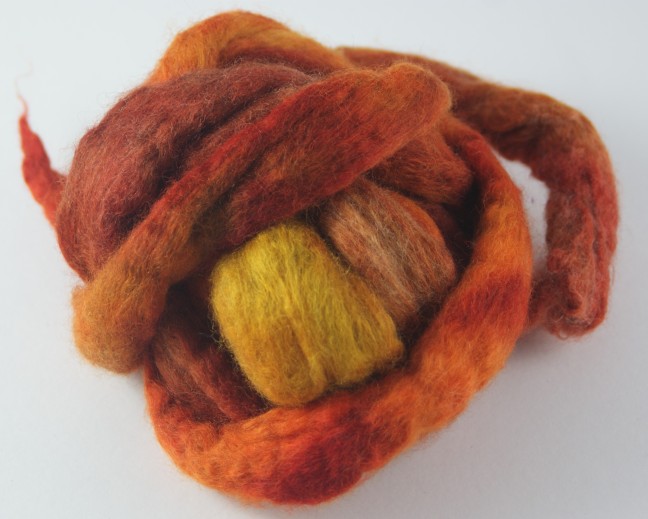
There was some ambiguity in the sources I’d read as to whether the wool could be left in the dye to react just at room temperature or required steaming, so I thought I’d give up reading and just see what results I’d get for myself.
The wool in question is 100% Bluefaced Lester (BFL), a lovely wool with relatively long staple fibres. It’s got a bit more lustre than things like merino and is particularly nice when blended with silk. I’d dyed a batch of this top before, so I already knew it was relatively clean so didn’t bother with any more intensive cleaning than just rinsing it a bit in cold water.
I soaked the fibre in an acidic mixture of water and citric acid. If you are a good person, looking for completely repeatable results from your dyeing, you would carefully measure the water to citric acid ratio to work out your pH but as I am not (and citric acid isn’t a strong acid either) I just bunged a load of citric acid in and left it to stand for a few hours.
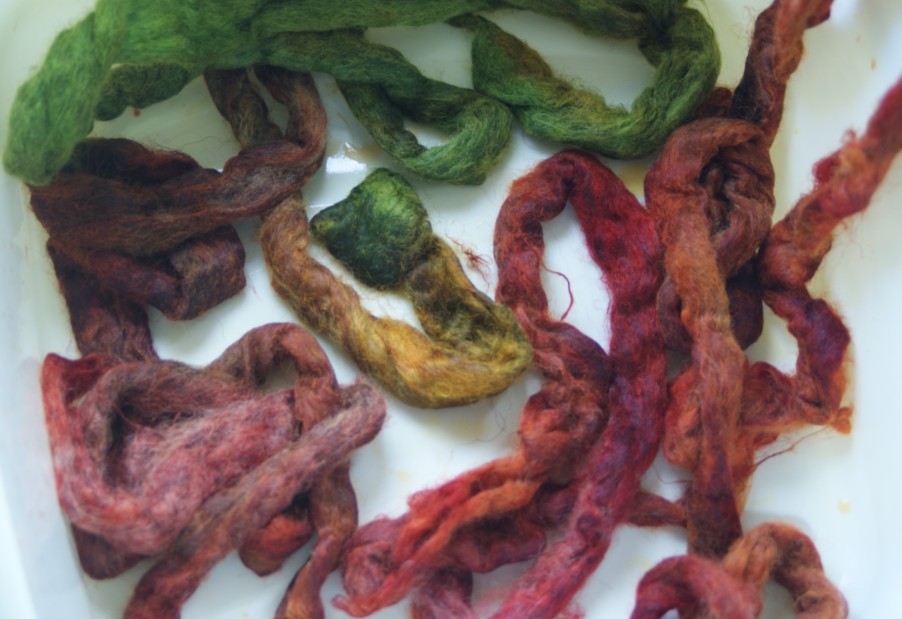
When I was ready to get dyeing, I made up my Procion MX dyes to about 5 % concentration with hot water and squeezed the worst of the water out of the top. I really need to learn to be more careful when handling wet top as the weight of it meant it managed to pull itself apart in a few places. It’s really quite unsurprising that sheep are so talented at drowning themselves with the volume of water that wool can hold.
Then, I just flung the dyes on in the usual fashion. I don’t normally add any acid/alkaline directly to the Procion MX dye stocks, instead I rely on the pre-soaking to give me the pH I need. I try to dye with the top as dry as possible as too much water in the top means you’re essentially diluting your dye solutions and can end up with paler colours than expected.
When that was done, I wrapped the top up in cling film, steamed it for an hour and waited with a great deal of impatience for it to cool down so I could rinse it. I am paranoid about touching freshly steamed wools. Although wool is generally a lot harder to felt than people give it credit for, I’d rather not take any chances.


As I was curious to see whether the steaming was necessary, I took a small sample of the top but didn’t steam it with the rest. This sample is one I left for 12 hours without heating and one that I steamed for an hour. As you can see, while the un-steamed sample has retained some of the dye on rising, the majority of it has not fixed properly and just been washed off.
I assume the chemical reaction that fixes the Procion dyes to the fibre is better catalysed by alkalis than acids, hence the need for steaming to speed up the fixing reaction when using an acid dye bath. I’m going to have to do a little reading to see if that speculation is actually correct or not.
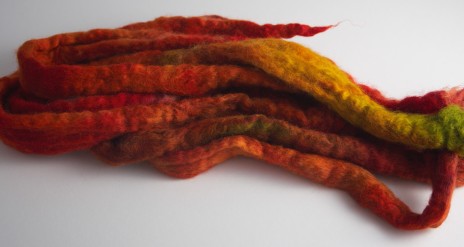
With the top rinsed and dried, I was really surprised to see how intense many of the colours had come out. I’m always a bit nervous working with reds and browns as it’s far too easy to cross the line from ‘rich autumnal’ to ‘bloody sludge’.
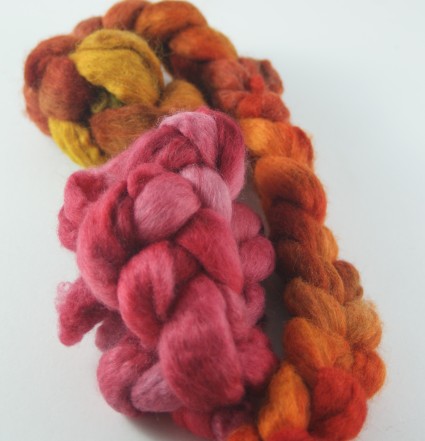
For comparison, the hideous red intestine looking wool is some BFL one I dyed using acid dyes. It’s not a true like-for-like in terms of the colour comparison but I’m not sure you’d be able to tell any difference in the dyeing process from looking at them. The fibre also seems completely unscathed by the dyeing process.
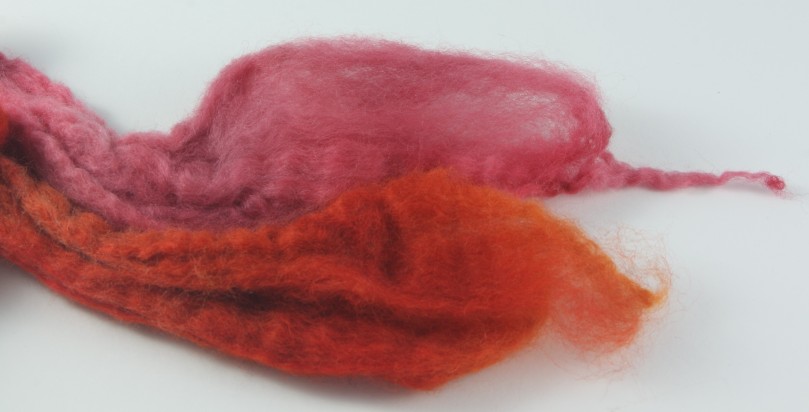
Overall, I’d say this worked absolutely as well as could be expected. The colours came out at the saturation levels and shades I anticipated, there’s no damaged to the fibre and the process is as quick and easy as using acid dyes. A good dyeing process is all about having control and in terms of that I have absolutely no complaints about unexpected, disappointing results here.
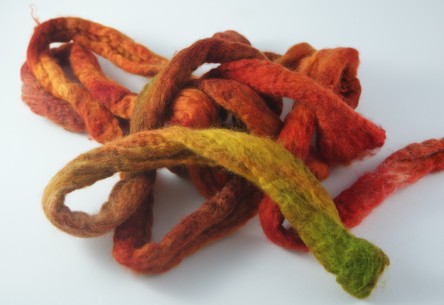
From this, I’d say there’s minimal difference between using Procion MX dyes to acid dyes on wool, at least at a superficial level. Just remember, if you’re using Procion dyes to steam the wool and make sure you use an acid, not an alkaline, dye bath. If you’ve had a go at doing this, I’d be really interested to hear about your results and experiences.
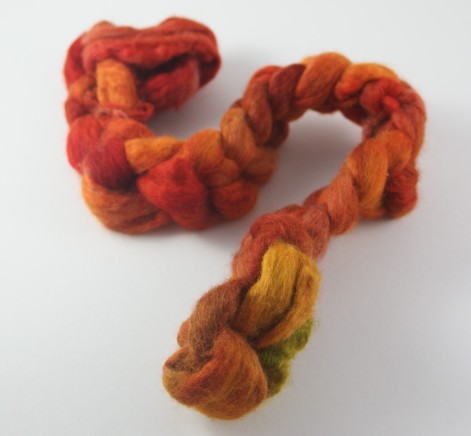

Such rich luscious colours.
LikeLiked by 1 person
Great results!
LikeLiked by 1 person
An interesting take on an age old subject. I had never thought of using procion dyes on wool. I was always told procion for plant fibres, acid dyes for animal fibres.
LikeLiked by 1 person
That definitely seems to be the standard advice. It’d be interesting to know if the Procion MX dyes remain as colourfast over time in comparison to acid dyes or whether there really is much advantage in using either other than personal preference.
LikeLike
I’ve used procion mx dyes on wool. I only have six acid dyes from a sampler kit but I have dozens and dozens of procion mx dyes from my fabric and tie dye days so I thought I’d give them a try. I was pleasantly surprised at how well the dyes stayed true to their colour or at least the colours I used did. The thing I didn’t like was the wash out. Acid dyes seem to get absorbed into the wool but mx seem to have a lot of excess dye left over. It’s quite possible that I used too much dye, I’m not sure. Wash out is more difficult because I don’t want to be too aggressive so it seems like forever washing out the excess dye.
LikeLiked by 1 person
It’s interesting you mention the wash out. I’ve had a lot of problems with huge amounts of wash out from silk with Procions (definitely an issue of too much dye to fibre) and cotton but this top seemed to eat up the dye quite nicely and I only had minimal rinsing. I do tend to find steaming helps get rid of a bit of the excess dye too. I don’t know about long term but the colours do seem to be colourfast with more rinsing. I should actually try using right amount of dye to right amount of fibre but it’s a pain to do.
LikeLiked by 1 person
Hmm, good point – steaming. Now that I think about it the major washout came from wool dyed in the pot not the wool I dyed by steaming so I guess I had too much dye in the pot or I wonder if the wool gets hotter when steamed so the dye adheres better? I try not to let the wool in the kettle come to a boil so it doesn’t felt. I don’t know maybe I just used too much dye.
I get different effects for the different methods. I’ll have to give steaming a go next time and see what happens. I just dumped some wool in tubs yesterday to soak overnight so lots to play with when they get washed 🙂
LikeLiked by 1 person
There’s so many variables to understand in dyeing… Hard to know where to start sometimes. Looking forward to seeing your next batches of wool!
LikeLike
This is interesting, I have lots of procion dye, never thought to use that with wool, I will give it a go
LikeLiked by 1 person
Wow I love the colours! Thats another Dye technique to add to my list of “must tries”. I’ve only done the dye in the grease which stinks lol. My mum has borrowed a book from a local woolcraft group which has a few different dye techniques in it, I want to try them all 🙂
LikeLiked by 1 person
Ooh, let me know what the book is called if you find it very helpful.
LikeLike
I haven’t had time to read it yet but it has a few techniques in to try from the index, microwave & steam, immersion, graduated, mixing colours, making stripes, painting, tie and dye then it goes into knitting patterns. its called dye one knit one by Helen Deighan & Linda De Ruiter 🙂 x
LikeLike
Great experiments and thanks for sharing. I still find dyeing very much a hit and miss process even with the acid dyes and getting good browns seems quite difficult as my blues seem to wash out quite readily. You’ve got some gorgeous colours here. Have you ever tried Wilton food colouring for dyeing? You can get split colours from one pot, but again it can end up looking a bit like intestines!
LikeLiked by 1 person
I think blues are notorious for washing out as most of them don’t bind to the fibre as well. I’ve never tried food colouring – although given my talent for dyeing things that look like intestines it might be the technique for me!
LikeLike
I experimented with Procion MX the other day on woolen locks and roving. I was quite prepared for it all to felt, and thought I could put it to use anyway, with the embellishing machine. The results were stunning. I mixed a few of the colours, carefully painting the wool I’d pre-soaked in a water/vinegar solution. I didn’t measure, but maybe half a cup of vinegar to water? Wrapped it in cling film and popped it in the microwave for 2 mins. This was not long enough, so I popped it back in the microwave until the clingfilm rose with the steam. Did this 3 or 4 times. Let it cool until it was lukewarm and then rinsed in lukewarm water. Had no felting whatsoever.
LikeLiked by 1 person
Excellent! Really happy to hear it all worked out. I think microwaving probably helps here as I guess without any agitation, even on heating you shouldn’t get too much felting. Thanks for sharing your methods!
LikeLike
This is a great article. Thank you
LikeLiked by 1 person
[…] blogged a bit about using Procion MX dyes with wool and I can confirm it does work. This is because a lot of Procion MX dyes can be used either as […]
LikeLike
My experience with using procion MX dyes on silk scarves has been similar. The colors are more mute, but they remain lovely. I have just started to explore dyeing wool roving. I dont realy want to have two sets of dyes, so will stick with the Procion MX for now. It is always such a wonder that anything happens at all!
LikeLiked by 1 person
[…] 15 % nylon, I much prefer acid dyes. You can use Procion MX dyes with acid conditions and they’ll dye wool, and to a lesser extent nylon, just fine but, if you have a choice of acid or Procion MX for this […]
LikeLike